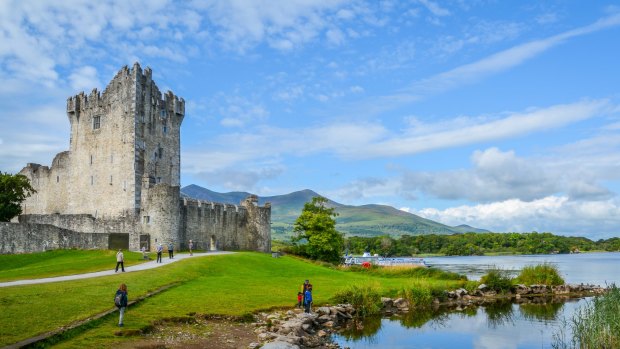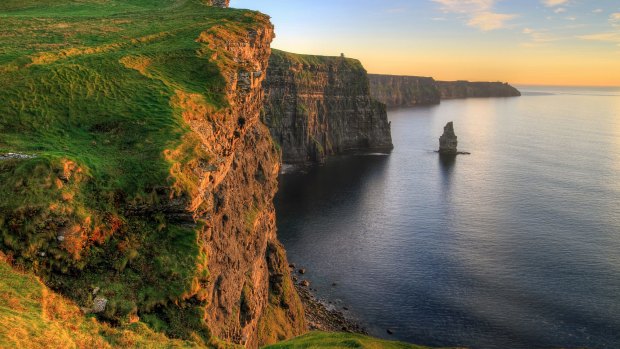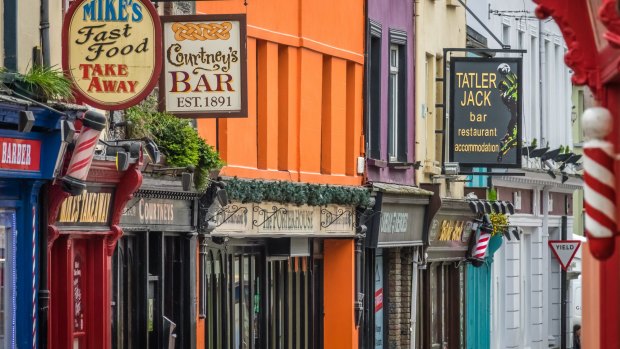This was published 6 years ago
Killarney National Park: The most eye-catching chunk of Ireland's 3000km-plus coastline
Forty shades of green and other-worldly surprises on the Emerald Isle.

Killarney Castle. Pictures don't do Ireland's scenery justice.Credit: Adobe Stock
It's not long after breakfast and we're buzzing along the mood-soothing, mountain-fringed waters of Lough Leane with silver-haired boatman Charlie Fleming and his cute half-chihuahua, half-Pomeranian pooch, Bella.
A fountain of local history and jokes (some dad-bad, others chuckle-worthy), delivered in his softly-spoken, south-west Irish twang, Charlie is showing us one of the prettiest pockets of his ''backyard'' – Killarney National Park, the oldest national park on the ever-so-enchanting Emerald Isle.
Spread across 10,000 hectares, a patchwork of lakes, peaks, moorland, meadows and forests, and key archaeological sites (such as Bronze Age copper mines), this richly-photogenic slice of County Kerry has been dubbed Ireland's version of England's Lake District.

The fabled Cliffs of Moher at sunset.Credit: Shutterstock
And it's welcomed some famous holidaymakers down the centuries, with the poet, Percy Bysshe Shelley, president Charles de Gaulle and Queen Victoria among those seduced by its dreamy landscapes and serenity. While the park begins on the doorstep of Killarney's quaint town centre, it's sometimes overlooked by the legions of tourists who flock to ''do'' the nearby Ring of Kerry, a 179-kilometre route around the Iveragh peninsula that's frequently touted as one of Europe's greatest road trips. We're not complaining, though. In fact, we're counting our lucky blessings as we appear to have Lough Leane – the park's largest and loveliest body of water – to ourselves.
We'd set off in Charlie's little wooden motor boat from outside Ross Castle, a greystone pile that was the last castle in Munster – Ireland's most south-westerly province – to be seized by Oliver Cromwell's armies after England ramped up the colonisation of its Celtic neighbour in the 17th century. As we navigate the lake in the shadow of the craggy, evocatively-named Tomies, Purple and Shehy mountains and past banks and slopes luxuriantly carpeted in oak, yew and rhododendron trees, everyone (Charlie and Bella excluded) clicks away on their smartphone cameras.
Pictures won't do the scenery justice, though – nor can they capture the ethereal, ever-changing light, as the sun creeps back and forth behind the puffy cumulus clouds. One of the park's biggest draws is wildlife watching, and we keep our eyes peeled for leaping salmon and soaring birds, including white-tailed sea eagles, re-introduced to the area a decade ago after more than 100 years of extinction.

Limerick, on the Emerald Isle.Credit: Shutterstock
We glimpse deer mooching by the shores of Innisfallen Island, one of the park's 20-odd pocked-sized islands. Ireland's only remaining wild herd of native red deer roam the Killarney area, but these are of the smaller, Sika (or Japanese) variety.
"They're very good swimmers. They can swim the length of the lake," says Charlie, who chills on his boat as we walk around this delightfully tranquil island with another charismatic local guide, Richard Clancy, and his red Irish setter, Rua. More deer are nibbling around the ruins of Innisfallen Abbey, a monastic settlement founded here in the seventh century by St Finian the Leper. The abbey's monks produced the Annals of Innisfallen, a cherished text that chronicles Ireland's medieval history, including its Viking and Norman invasions.
Now housed at the Bodleian Library in Oxford, the annals are why Lough Leane is nicknamed ''The Lake of Learning''. We continue our cruise into Leane's neighbouring, adjoining lakes, beneath stone bridges, past reed-beds, bushy islets and lakeside cottages, before docking outside Muckross Estate, one of the park's stately homes and gardens. Led by Richard and Rua, we hike across a fetching, deserted beach and through ancient woodland of oak, birch and ash where you could imagine goblins, trolls and leprechauns lurking behind the twisting trunks and branches.
After pausing by Torc Waterfall – little more than a trickle after recent dry weather – we carry on walking, brushing past teeming ferns, meadows crawling with black cattle and through grassland studded with tall trees, such as Monterey pines from California.
"They grow bigger here than over there," says Richard. "They tend to drink more here, you see …"
After being guided around in the morning, we're left to our own devices for the afternoon, and I delve deeper on the park's forested trails.
The scenery is bucolic, the air fresh, crisp and invigorating, and there's a peace and quiet that's pierced, from time to time, by birdsong, deer rustling in the undergrowth, and the clip-clopping of ''jaunting cars'' (horse-drawn carriages traditionally ridden in the Killarney area and now a popular mode of transport to cart tourists around).
Later, my feet aching a tad, but back in the land of Wi-Fi and mobile phone signals, I dine on creamy seafood chowder and slow-roasted tender Kerry lamb shank at Caragh Restaurant, one of the cosy, family-run eateries in Killarney town.
Next morning, we're on the road again, venturing through County Limerick and into County Clare, where we lunch beside the fabled Cliffs of Moher.
This is possibly the most eye-catching chunk of Ireland's 3000-kilometre-plus coastline.
Clifftop trails thread north and south, with short, walled paved sections giving way to exposed narrow paths that you can ramble along, knees trembling, butterflies fluttering in the stomach, no doubt, as you peer down at the Atlantic waves crashing against the shale and sandstone cliffs, which rise 200 metre high in parts.
"A little scary, but gorgeous," is the verdict of the American tourist beside me.
She's not wrong, especially as the weather keeps changing.
One minute, an Atlantic storm threatens to roar in, everything is shrouded in mist and drizzle and we struggle to see the anorak-clad figures being blown by the wind in front of us; the next it's all clear, and we gaze out at the vast, becalmed ocean and the offshore Aran Islands, which are famed for their high-quality wool sweaters.
They can be purchased from the little shops clustered by Moher's modern visitor centre, which is embedded into the cliffs, has cafes and immersive displays tracing the cliffs' geology and birdlife.
Touring Ireland with Collette, barely an hour passes without someone commenting just how incredibly green everything is.
When he visited Ireland in 1959, the American country singer Johnny Cash wrote Forty Shades of Green in homage, and as I glance out of our tour coach window, I find myself jotting down stuff like ''pea-green'', ''Golum-green'', ''Hulk-green'', ''Kermit-green''.
When we arrive in The Burren, however, it feels like we're in a different country.
This is still Ireland, though – just not as we know it.
Tucked inland from the coast, The Burren is Gaelic for ''rocky place'', and it's characterised by its jagged limestone landscapes that were shaped beneath the sea more than 300 million years ago, before being forced up by tectonic activity, and weathered by the elements over millennia, including the last Ice Age.
Helping us make sense of it all is Stephen Hegarty, a local farmer and tour guide, who hops aboard to regale the region's myths and legends, history and geography.
Despite looking fairly alien and inhospitable, a stark contrast to the gentle rolling greenery that dominates the Irish countryside, human life – and farming – has long flourished here, climate-wise one of the mildest parts of Ireland, thanks to the warming Gulf Stream that drifts up from Mexico.
We pass patches of pastoral fields, where ponies, sheep and cows graze, and a few Iron Age stone forts (more than 500 dot the region), before pulling in at Poulnabrone, a chambered Neolithic tomb that pre-dates Stonehenge and the pyramids of Giza.
Excavated in 1986, it sheltered ancient pottery, jewellery and the remains of 16 people.
Sprouting from the limestone cracks at this burial site are wildflowers, which bloom across The Burren in large numbers, and in great variety, each spring.
"These plants normally grow thousands of kilometres apart, and at different altitudes," says Stephen, who we drop off in Kilfenora, one of The Burren's villages, which is famed across Ireland for spawning one of the country's most celebrated folk music acts.
The Kilfenora Ceili Band usually play at Ennis Trad Fest, an annual November gathering in County Clare's largest town, a song-and-dance-fuelled place where our Irish Adventure comes to a close.
After my farewell group dinner – prawn and smoked salmon cocktail, sirloin of Irish beef in red wine sauce and chocolate truffle cake – at the Old Ground Hotel, a spruced-up 18th century landmark, I amble round Ennis' neat town centre, popping into half-a-dozen snug bars and pubs, all buzzing with live music.
Buoyed by an uplifting week on the Emerald Isle, I glance around and wonder who's enjoying themselves most: the grinning, pint-holding, wine-glass-clutching, toe-tapping punters – or the musicians, young and old, in their element, whirling away on their violins, fiddles, flutes and accordions.
TRIP NOTES
MORE
FLY
Etihad and Qatar Airways fly to Dublin from Sydney and Melbourne via Abu Dhabi and Doha respectively. See etihad.com and qatarairways.com
TOUR
Collette runs a series of tours around Ireland, including a seven-day Irish Splendour option, which starts in Dublin and includes visits to Killarney, the Cliffs of Moher and Ennis. It's priced from AU$1689. See gocollette.com
FIVE MORE HIGHLIGHTS OF COLLETTE'S TOURS OF IRELAND
DUBLIN
Try pouring your own pint of Guinness at the ''Temple of Guinness'' – the Guinness Storehouse – and enjoy a guided stroll around Trinity College and other historical sights in Ireland's vibrant capital.
IRISH NATIONAL STUD
Discover the secrets of the horse-breeding business – and go nose-to-nose with champion stallions like Invincible Spirit – at the stud's lush paddocks, stables and curiously-named ''Teasing Shed''.
ROCK OF CASHEL
Scale this former royal fortress, which crowns a hill in the grassy plains of County Tipperary. It's one of Ireland's most celebrated archaeological sites, with a round tower dating back to the early 12th century.
IRISH COOKING CLASS
Prepare and savour dishes like Atlantic salmon pate on soda bread, a salad of quails' eggs, black pudding and Cashel blue cheese, and chive-infused honey-glazed ham with garlickly wok-fried cabbage, plus Irish coffee (infused with Bushmills whisky).
HOLYCROSS ABBEY
Admire the decorative stained glass windows and godly antiques of this restored Cistercian monastery, a medieval pilgrim site nestled by the River Suir in the picturesque Tipperary village of Holycross.
Sign up for the Traveller Deals newsletter
Get exclusive travel deals delivered straight to your inbox. Sign up now.